COPYRIGHT, PLEASE NOTE
All the material on this website is copyrighted to J-P Metsavainio, if not otherwise stated. Any content on this website may not be reproduced without the author’s permission.
BUY A MUSEUM QUALITY POSTER
BUY A POSTER:https://astroanarchy.zenfolio.com/
Friday, November 14, 2008
Star Removal PS action, klick the image to download
OBSOLITE PAGE, PLEASE, DOWNLOAD THE STAR REMOVAL PS ACTION FROM HERE: Star removal PS Action
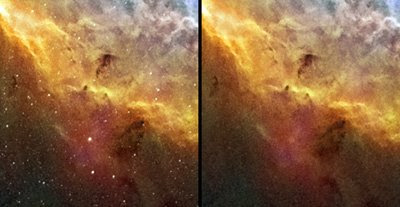
Many astroimagers had asked me to reveal the method of removing Stars.
It's sometimes very usefull to be able to remove stars from the image.
Some dense Starfields can cover nebula details or the Star bloat can cause
problems with narrowband color mixing.
I have now made a PhotoShop Action for StarRemoval!
NOTE! The primary use is for Nebulae!
It might or might not work with Galaxy images
-
It has not been tested, so if there is problems or not, please leave a comment.
There might be some large stars, or fracments of them, in the image
after action. They are easy to remove manually.
The action result can vary, depending many factors, Star size, density, etc...
If you like, you cant tweak the parameter in the action for better result.
Or you can use just some part of the action. Be free to experiment.
-
In my tests I noticed, this works very well to undersampled images >
usuall wide fields one. And there the dence stars are really a problem.
To be sure, that no wanted information is lost, place the starless
image as a layer top of the original and blink.
Then use eraser to restore brighter details.
If you set the transparency, let's say 50%, you can have part of the both worlds.
-
In Cloudynights CCD-imaging group, there is some feedback of this action.
You can find help in there as well, if you have had some problems.
-
-
There has been lots of work to develop this kind of technic.
If you feel, that you like to support my work, please, use a donate Button in the Right hand side Menu.
Thank You!
Labels:
PS-actions,
research and development
Tuesday, November 11, 2008
NGC1499, the "California Nebula" as a Stereo pair
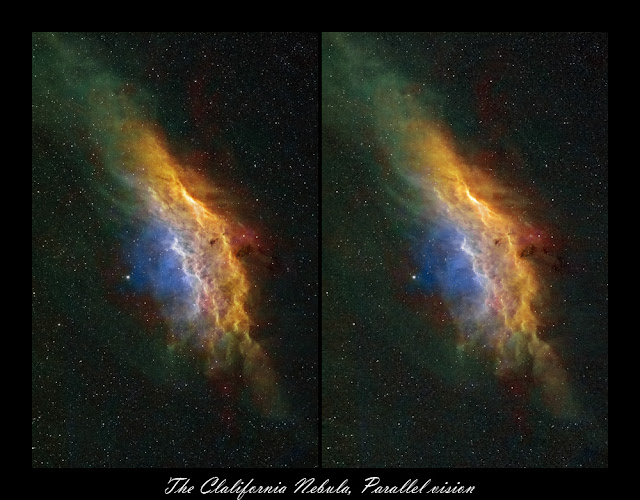
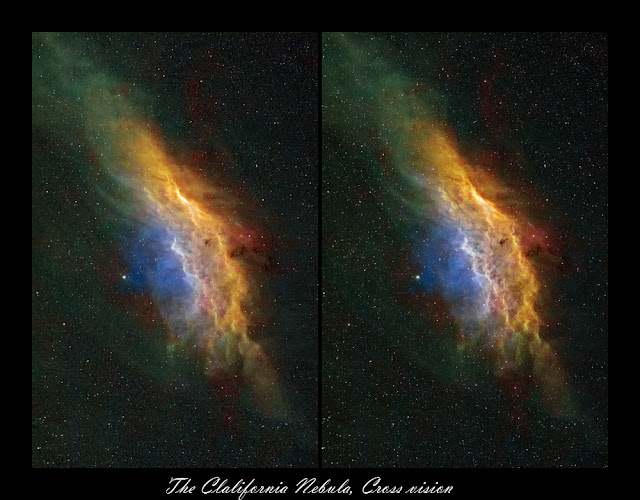
This target reveals new structures in emission line imaging.
I made this presentation to show, how to I see, the structure
of this beautiful nebula.
-
Triple ionized Oxygen (O-III) signal was weak,
it can be seen as a Blue in the image. It seems to reach up to bright
star "Menkib" (HIP18614).
Menkib is energizing the strong emission from NGC1499,
outburs of O-III looks like relating to it.
Very interesting, but I don't know is this well known phenomen.
-
As usual, there is two versions. One for parallel vision, and the other one for cross vision methods. Thats because some part of the viewers can see one of the method in 3D, but not the other. (I can't see cross vision images - How to see this in 3D? Please, look for the right hand side menu for instructions.
 Klick this image, if you can't see either of the stereo methods above. This is a animated image showing steroimage as a small animation. It will gives an idea, what can be seen in stereo images.
Klick this image, if you can't see either of the stereo methods above. This is a animated image showing steroimage as a small animation. It will gives an idea, what can be seen in stereo images.
-
Link to the original imaging data and the image:
Labels:
stereo images
Monday, November 10, 2008
Sh2-157
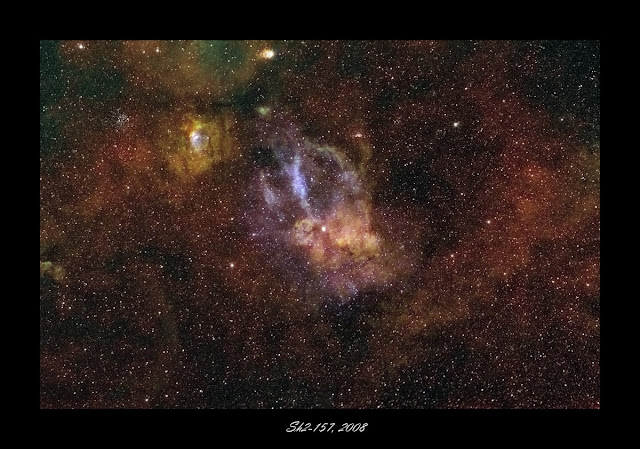
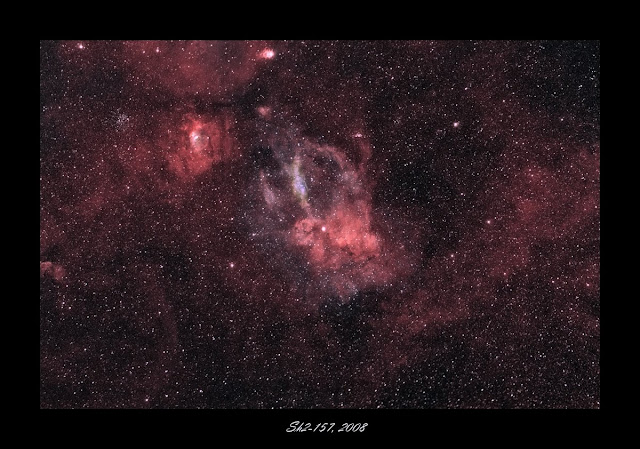
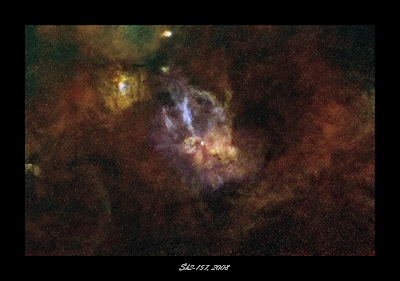
My Sharpless Catalog project continue with Sh2-157.
Sh2-157 is a faint large nebula. Famous Bubble Nebula can be seen in upper left corner.This nebula looks like a gigant termite head to me.
Three versions precented here, first is in a Hubble palette,
second in "natural" colors and
third is an image with reduced stars to better show nebulosity, there seems to be lots offaint double ionized Sulfur (S-II) around.
-
Imaging data: Camera, QHY8 - Filters, Baader 7nm H-alpha, Baader 8,5nm O-III and Baader 8nm S-II - Optics, Tokina AT-X 300mm @ f2.8 - Exposures, 5X 1200s H-alpha, 2 X 1200 O-III and 2X1200s S-II + flats and bias - Guiding, LX200 GPS 12" + PHD-guiding and Lodestar
Sunday, November 9, 2008
IC405 & IC410
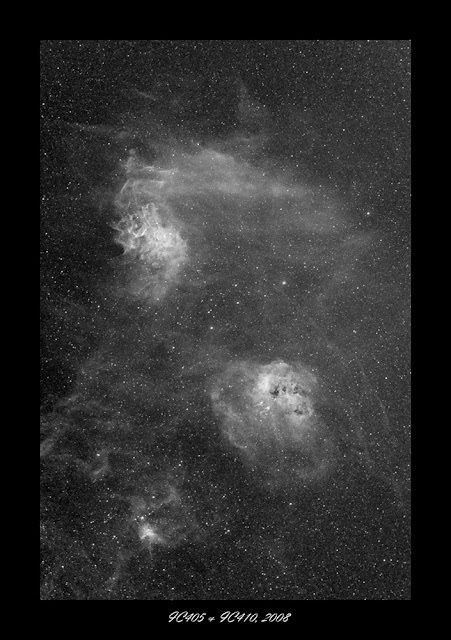
It's nice to make a black and white image
after so colorfull shots.
In the image there is two main objects, IC410 and IC405, sometimes
called as a "Flaming Star Nebula".
IC405 is a emission nebula but it has reflecting nebulosity too.
In my heavily lightpolluted location it's not easy to capture.
Trough Hydrogen alpha filter just emission part is captured.
Some info in Wikipedia: http://en.wikipedia.org/wiki/IC_405
-
Imaging data:
Camera, QHY8 - Filters, Baader 7nm H-alpha - Optics, Tokina AT-X 300mm @ f2.8
- Exposures, 5X 1200s H-alpha + flats and bias - Guiding, LX200 GPS 12" + PHD-guiding and QHY5
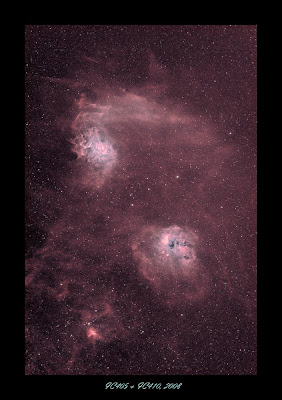 Editted 9.11.
Editted 9.11.
Ok. I can't live without colors, let's face it,
so I added this false color Ha-composition here.
Red = Starless Ha 100% R = 0% B = 17% Ha (Works as a H-beta substitute)
Subscribe to:
Comments (Atom)








